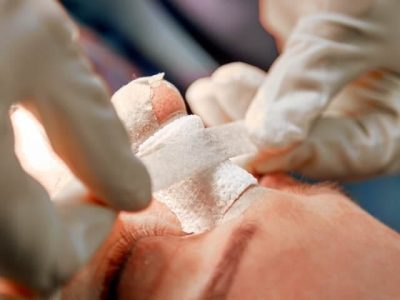Endoscopic Face Lift
Also known as a “scarless” facelift, this procedure lifts the forehead, brows, midface, and sometimes cheek tissues through small incisions, using an endoscope.
The endoscopic facelift is ideal for individuals aged 35–55 who exhibit mild to moderate signs of aging, such as muscle sagging, cheek laxity, mild nasolabial folds, and mild jawline drooping. It is a highly effective approach for addressing these intermediate aging concerns. It’s especially important that these patients do not have poor skin elasticity. Other hand It is not recommended for those with extensive skin laxity or extensive pronounced jowls, where more comprehensive procedures such as traditional or deep-plane facelifts may be necessary to achieve optimal results. Best outcomes in patients without extensive skin excess looser patients may need traditional lift.
SURGICAL TECHNIQUE
Incisions are classically made as a single 30 mm cut above the temporal hairline on the scalp. If a jawline or chin lift is also required, additional incisions may be added either behind the ear or in front of it. A miniature endoscope is inserted to provide magnified, precise visualization of deeper tissues. This allows the surgeon to release, elevate, and reposition the midfacial and SMAS layers using vertical vectors, effectively counteracting gravitational descent . After tissues are elevated, muscles and fat pads are anchored to stable deep fascia or bone, and the incisions are carefully closed with fine sutures. The procedure typically lasts 2 to 3 hours under general anesthesia.

Endoscopic Neck Lift (Endoscopic Cervical Lift)

An endoscopic neck lift is a minimally invasive cosmetic procedure designed to improve neck contour using small incisions (typically in the submental crease and postauricular areas), along with an endoscope—a miniature camera. The goal is to tighten muscles (platysma), remove excess fat, and reshape deep neck structures (like submandibular glands and digastric muscles) to create a smoother, more defined neckline.
The endoscopic neck lift is particularly suited to individuals aged 40–60 who exhibit early to moderate neck laxity, including those with submental fullness, platysma muscle banding, or descent of midline neck structures.
This procedure benefits patients seeking a more refined jawline and neck contour without extensive scarring. It is especially effective when skin elasticity is adequate and neck aging hasn’t advanced drastically.
SURGICAL TECHNIQUE
The procedure begins with the creation of small incisions under the chin and/or behind the ears. Through these portals, an endoscope is introduced to visualize underlying structures. Using this minimal access, the surgeon performs several steps:
- Tightens or removes lax platysma bands (“corset” platysmaplasty) to smooth out neck musculature.
- Suctioning of subplatysmal fat, which enhances the cervicomental angle and defines the jawline.
- Optional sculpting of submandibular glands and trimming of digastric muscles to improve neck contour further.
The overall result is a more defined jawline and a smoother neckline, achieved through precise, minimally invasive maneuvers with reduced recovery time and scarring.
BENEFITS of ENDOSCOPIC FACE AND NECK LIFT
- Minimal visible scarring- Incisions hide in hair.
- Less trauma and downtime compared to full facelifts.
- Improved precision through magnification of deep structures.
RECOVERY of ENDOSCOPIC FACE AND NECK LIFT
After an endoscopic facelift, patients typically experience mild swelling and bruising that can last 10 days . Sutures are usually removed within 7–10 days, and most individuals can return to normal daily activities by around two weeks, though subtle swelling may persist a bit longer . The final results of the procedure generally become visible by about one month, once all residual swelling has resolved and tissues have fully settled.
LONGEVITY & LIMITATIONS of ENDOSCOPIC FACE AND NECK LIFT
The rejuvenating effects of an endoscopic facelift can endure for 7-10 years, influenced by factors such as skin quality, ongoing sun exposure, and lifestyle choices . It’s most effective for those in the early -mid stages of facial aging, specifically for mild to moderate sagging or laxity.

IS ENDOSCOPIC FACE LIFT COMPLETELY SCARLESS?
Endoscopic facelifts are often referred to as “scarless,” but that doesn’t mean there are no scars it means the incisions are very small (20-30 mm) and discreetly placed, usually hidden behind the hairline or in less visible areas.
ARE NERVE INJURIES COMMON?
In the endoscopic approach, both the excellent definition of facial layers and the avoidance of unnecessary tissue elevation significantly reduce the likelihood of nerve injury. Endoscopic cameras often reduce risk, but there remains a small possibility of temporary weakness or altered sensation.
WHEN CAN I GO BACK TO WORK?
Most patients return within 2 weeks, once swelling and bruising subside.
WHAT IS THE DURABILITY OF ENDOSCOPIC FACE LIFT RESULTS?
Expect results to last several years (7-10 years). However, future aging continues, and maintaining good skin care and healthy habits helps prolong effects.





